Research - (2021) Volume 9, Issue 2
Knowledge, Attitude and Practice Survey on Various Types of Access Cavity Preparations in Posterior Teeth among Endodontists and Post Graduate Students Residing in South India
Mulumoodi Rama Sowmya* and Manish Ranjan
*Correspondence: Mulumoodi Rama Sowmya, Department of Conservative Dentistry and Endodontics, Saveetha Dental College and Hospitals, Saveetha Institute of Medical And Technical Sciences, Saveetha University Tamilnadu, India, Email:
Abstract
The aim of this survey is to assess the knowledge, attitude and opinion on various types of access cavity preparations in posterior teeth among endodontists and post graduate students in south India. A questionnaire containing 15 questions were formulated and circulated through electronic media among various dental practitioners in India. This survey revealed that more than twothirds of the respondents had knowledge about various types of access cavity preparations in posterior teeth in Endodontic. Most of the respondents felt that this treatment strategy should be incorporated into dentistry. However, the results indicated that more than one third of the respondents were not aware of the techniques and steps involved in these minimally invasive endodontic procedures. The results reflected that most of the dentists have knowledge about various types of access cavity preparations in posterior teeth and are keen on practicing the same. However, the results also showed that most of the dentists wanted the implementation of the procedures in an effective way to reach out to the patients.
Keywords
Cala lilly preparation, Dental practitioners, Minimally invasive endodontics, Ninja access, Truss access
Introduction
The objective of root canal treatment is to render the root canal free of microbes which is virtually impossible in reality. In the quest of eradicating microbes from the root canal, the clinician should also make sure to conserve the tooth structure as much as possible; because extensive removal of tooth structure while doing the preparation might weaken the remaining tooth structure which can adversely affect the prognosis of the tooth. Hence it is always imperative to employ minimal invasive endodontic procedures while doing root canal treatment [1].
This sort of minimalistic approach always begins with the first step in the root canal procedure, that is, access cavity preparation. The three factors of a successful root canal therapy are access cavity preparation, cleaning, disinfecting and shaping the canal and 3D obturation of the canal which should give a fluid tight seal to the canal [2] Out of the three factors, access cavity preparation poses a greater challenge to the clinician. This is because inadequate or improper access cavity preparation may lead to hindrance in locating the canal, negotiating the canal, instrumenting the canal and subsequent procedures thereafter [3].
For a long time, clinicians have been practicing GV Black’s method of access cavity preparation which is called the ‘Traditional endodontic access cavity’ (TEC) which provides straight line access and provides adequate room for biomechanical preparation of the canal [3]. However, this mode of preparation does not allow for conservation of tooth structure. A lot of tooth structure is sacrificed in this approach which might necessitate a proper post endodontic restoration that can help stabilize the remaining tooth structure [1,4]. This may hamper the resistance to fracture under loading. Hence offlate, new and modern approaches are cropping up in the field of endodontics which makes it for conservation of tooth structure as well as proper biomechanical preparation [4].
The recent evolution is the ‘Conservative Endodontic Access Cavity’ (CEC) proposed by Clark et al. in which there is a revolutionary shift from traditional approach to minimalistic approach wherein there is a greater dentin preservation and idealization of endodonticrestorative interface. The main objective of CEC is to preserve the tooth structure and pericervical dentin [5].
Nevertheless, the basic concept of minimally invasive endodontics is still related to the conservation of sound tooth structure during access cavity preparation, scouting the canal, glide path, and mechanical instrumentation [6]. For this reason, the recent instruments have adopted the aspects of minimally invasive concepts and philosophy [6]. The topic is still controversial as the minimally invasive endodontics concept is responsible for a less efficacious irrigation, cleaning and disinfection of the root canal system [7] However, new irrigation protocols and disinfecting devices and antibacterials incorporating the principles of nanotechnology have been emerging off late. Hence this can be an answer to the above mentioned accusations [8].
MIE refers to the removal of dentin minimally during the all three phases of a root canal procedure: (1) Coronal access preparation; (2) Radicular preparation apically and (3) Flaring of the canal which is connecting the coronal preparation to the apical preparations [8].
To evaluate biological success and survivability of the tooth there are three essential aspects in endodontics that a clinician should keep in mind which are mentioned as follows [6-8].
✓ Biological success can be gained by removal of the microbes from apical 3 mm to 4 mm
✓ With the minimalistic approach and minimal removal of the tissue in the coronal two-thirds of the root, there are chances of long-term survivability of the tooth.
✓ A proper access to the root canal from both coronal and apical aspect is critical.
The human stomatognathic system creates a lot of demands on human mastication and impacts the long term outcomes clinically which remain as a gold standard for evidence. Evidence is there that not only in endodontically treated teeth but also in normal tooth fracture can occur under physical loads. It stated that without any endodontic treatment, all teeth, especially molars, can fracture [8].
Once a fracture begins in the root, it serves as a pathway for accumulation of bacteria, food debris and forming necrotic tissue which causes inflammation of the apical periodontium. Yeh et al. suggested that heavy masticatory forces can cause root fracture [7].
Henceforth, this revolutionary approach of MIE may change the dynamics of endodontics in future and can shift the focus from ‘extension for prevention’ to ‘prevention of extension.’ A lot of scope can be provided to lay a new platform to build up modern approaches to conserve the tooth structure and work in the best interest of patients [1,4].
We have numerous highly cited publications on well-designed clinical trials and lab studies [9-25]. This has provided the right platforms for us to pursue the current study. The aim of this study is to assess the awareness among endodontists and post graduate students on different types of modern endodontic access cavity preparations in posterior teeth.
Materials and Methods
A cross-sectional study was conducted across dental practitioners practicing in Chennai. A questionnaire consisting of 15 questions were formulated. These questions were divided into three parts, namely, knowledge, attitude and practice. Based on the responses from various dental practitioners to this multiple choice based questionnaire, the survey was analysed. This questionnaire was circulated through electronic media. The participants of this survey belonged to various fields of dentistry across Chennai.
Results and Discussion
In this study, it is seen that most of the practitioners (92.7%) are aware of various conservative access cavity preparations and its modifications. Among the participants, 66% of them came to know about this through articles and 55% came to know through professors. 55% of the participants find that ninja access cavity preparation has a better access to canal orifice and also 44% of the population opine that ninja access cavity preparation has a good prognosis on the remaining tooth structure. It can be inferred from this data that most of the practitioners are aware of ninja access cavities compared to other conservative access cavity preparations. However, 55% of the practitioners opine that all types of conservative access cavity preparations have a better influence on the remaining tooth structure. On the contrary to the previous studies, in this survey 43% of the dentists find better enabling of cleaning and shaping of the canals after access cavity preparation. 53% of the population finds that all types of CEC preparations are wiser compared to traditional access cavity preparations. But 46.8% of the participants opine that these modified conservative preparations may or may not be required at all times in the clinical set up (Figures 1 to 15).
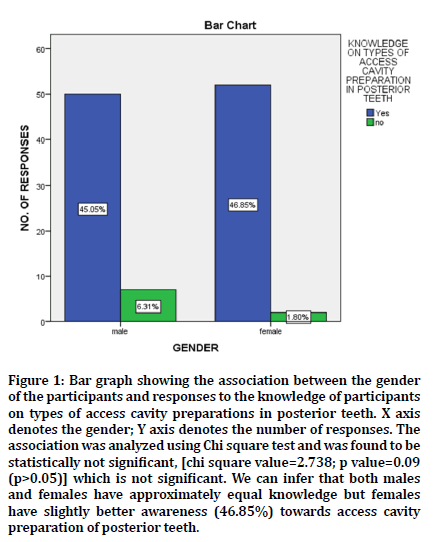
Figure 1. Bar graph showing the association between the gender of the participants and responses to the knowledge of participants on types of access cavity preparations in posterior teeth. X axis denotes the gender; Y axis denotes the number of responses. The association was analyzed using Chi square test and was found to be statistically not significant, [chi square value=2.738; p value=0.09 (p>0.05)] which is not significant. We can infer that both males and females have approximately equal knowledge but females have slightly better awareness (46.85%) towards access cavity preparation of posterior teeth.
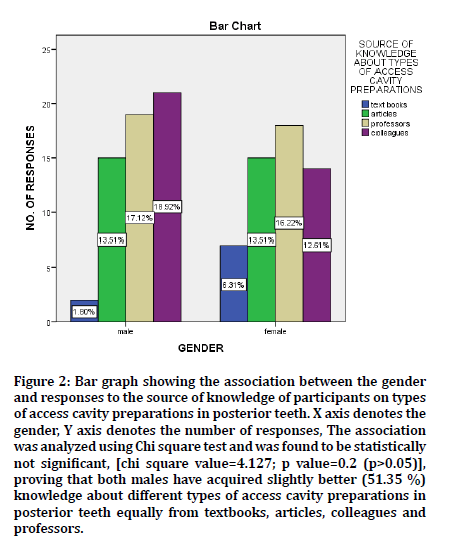
Figure 2. Bar graph showing the association between the gender and responses to the source of knowledge of participants on types of access cavity preparations in posterior teeth. X axis denotes the gender, Y axis denotes the number of responses, The association was analyzed using Chi square test and was found to be statistically not significant, [chi square value=4.127; p value=0.2 (p>0.05)], proving that both males have acquired slightly better (51.35 %) knowledge about different types of access cavity preparations in posterior teeth equally from textbooks, articles, colleagues and professors.
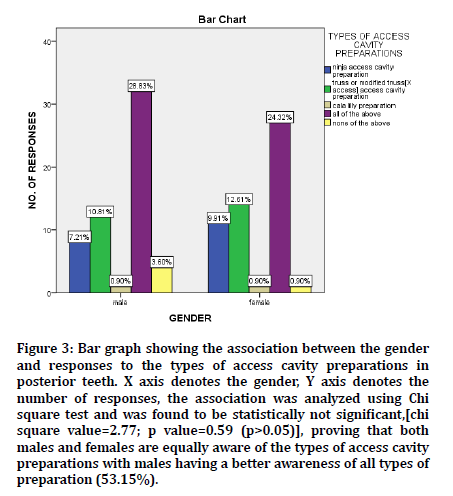
Figure 3. Bar graph showing the association between the gender and responses to the types of access cavity preparations in posterior teeth. X axis denotes the gender, Y axis denotes the number of responses, the association was analyzed using Chi square test and was found to be statistically not significant,[chi square value=2.77; p value=0.59 (p>0.05)], proving that both males and females are equally aware of the types of access cavity preparations with males having a better awareness of all types of preparation (53.15%).
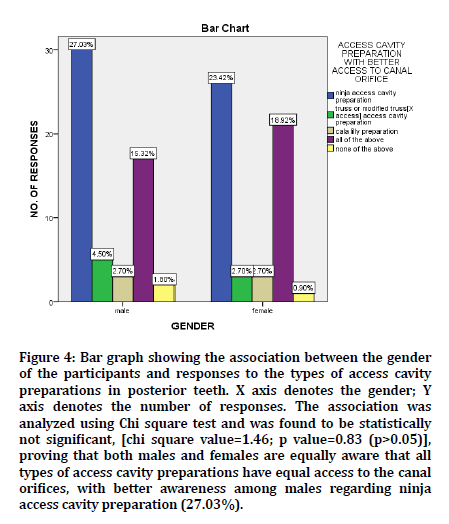
Figure 4. Bar graph showing the association between the gender of the participants and responses to the types of access cavity preparations in posterior teeth. X axis denotes the gender; Y axis denotes the number of responses. The association was analyzed using Chi square test and was found to be statistically not significant, [chi square value=1.46; p value=0.83 (p>0.05)], proving that both males and females are equally aware that all types of access cavity preparations have equal access to the canal orifices, with better awareness among males regarding ninja access cavity preparation (27.03%).
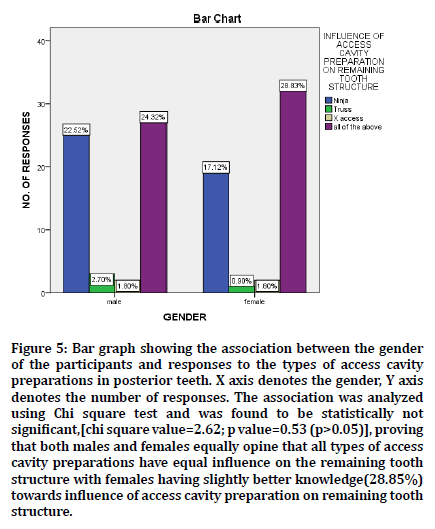
Figure 5. Bar graph showing the association between the gender of the participants and responses to the types of access cavity preparations in posterior teeth. X axis denotes the gender, Y axis denotes the number of responses. The association was analyzed using Chi square test and was found to be statistically not significant,[chi square value=2.62; p value=0.53 (p>0.05)], proving that both males and females equally opine that all types of access cavity preparations have equal influence on the remaining tooth structure with females having slightly better knowledge(28.85%) towards influence of access cavity preparation on remaining tooth structure.
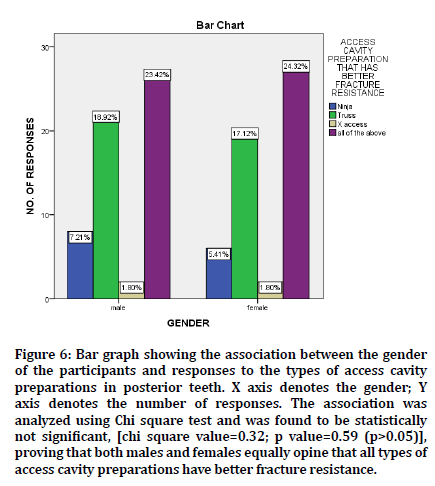
Figure 6. Bar graph showing the association between the gender of the participants and responses to the types of access cavity preparations in posterior teeth. X axis denotes the gender; Y axis denotes the number of responses. The association was analyzed using Chi square test and was found to be statistically not significant, [chi square value=0.32; p value=0.59 (p>0.05)], proving that both males and females equally opine that all types of access cavity preparations have better fracture resistance.
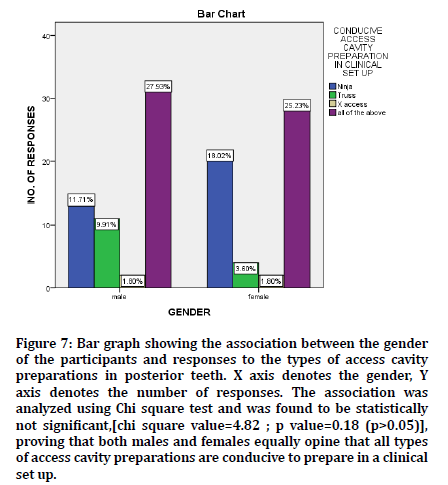
Figure 7. Bar graph showing the association between the gender of the participants and responses to the types of access cavity preparations in posterior teeth. X axis denotes the gender, Y axis denotes the number of responses. The association was analyzed using Chi square test and was found to be statistically not significant,[chi square value=4.82 ; p value=0.18 (p>0.05)], proving that both males and females equally opine that all types of access cavity preparations are conducive to prepare in a clinical set up.
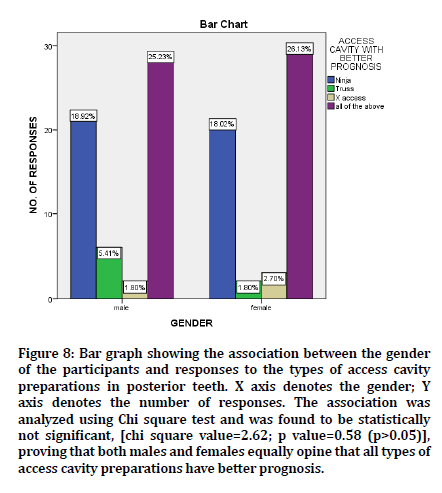
Figure 8. Bar graph showing the association between the gender of the participants and responses to the types of access cavity preparations in posterior teeth. X axis denotes the gender; Y axis denotes the number of responses. The association was analyzed using Chi square test and was found to be statistically not significant, [chi square value=2.62; p value=0.58 (p>0.05)], proving that both males and females equally opine that all types of access cavity preparations have better prognosis.
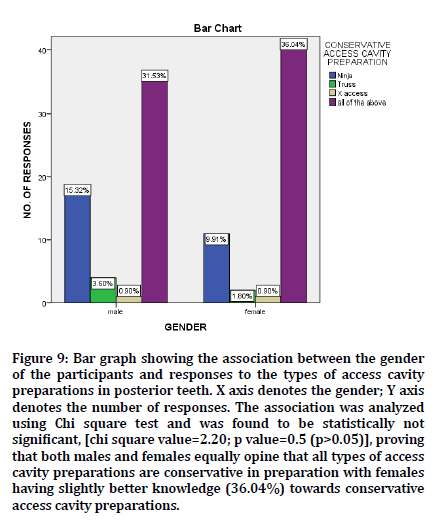
Figure 9. Bar graph showing the association between the gender of the participants and responses to the types of access cavity preparations in posterior teeth. X axis denotes the gender; Y axis denotes the number of responses. The association was analyzed using Chi square test and was found to be statistically not significant, [chi square value=2.20; p value=0.5 (p>0.05)], proving that both males and females equally opine that all types of access cavity preparations are conservative in preparation with females having slightly better knowledge (36.04%) towards conservative access cavity preparations.
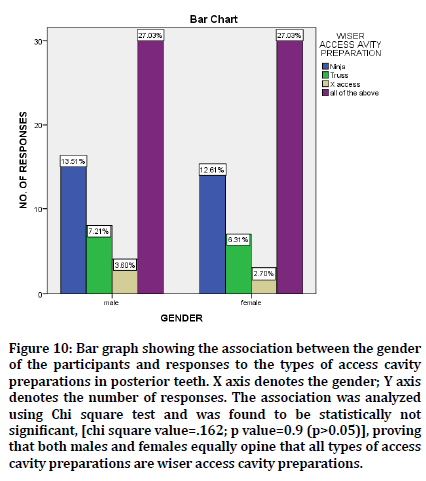
Figure 10. Bar graph showing the association between the gender of the participants and responses to the types of access cavity preparations in posterior teeth. X axis denotes the gender; Y axis denotes the number of responses. The association was analyzed using Chi square test and was found to be statistically not significant, [chi square value=.162; p value=0.9 (p>0.05)], proving that both males and females equally opine that all types of access cavity preparations are wiser access cavity preparations.
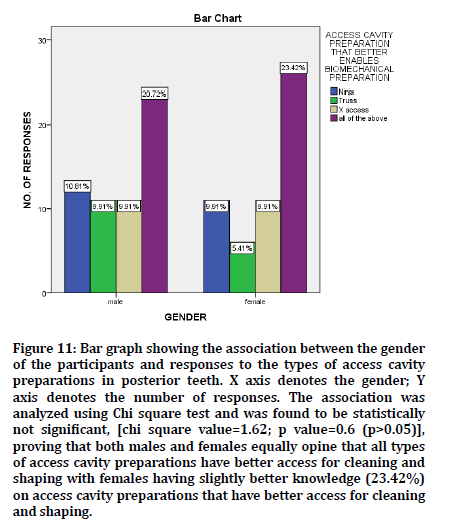
Figure 11. Bar graph showing the association between the gender of the participants and responses to the types of access cavity preparations in posterior teeth. X axis denotes the gender; Y axis denotes the number of responses. The association was analyzed using Chi square test and was found to be statistically not significant, [chi square value=1.62; p value=0.6 (p>0.05)], proving that both males and females equally opine that all types of access cavity preparations have better access for cleaning and shaping with females having slightly better knowledge (23.42%) on access cavity preparations that have better access for cleaning and shaping.
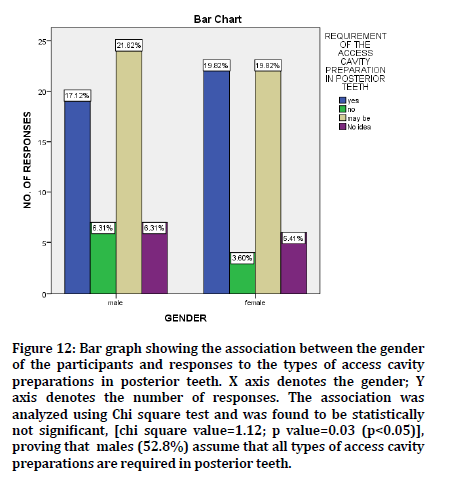
Figure 12. Bar graph showing the association between the gender of the participants and responses to the types of access cavity preparations in posterior teeth. X axis denotes the gender; Y axis denotes the number of responses. The association was analyzed using Chi square test and was found to be statistically not significant, [chi square value=1.12; p value=0.03 (p<0.05)], proving that males (52.8%) assume that all types of access cavity preparations are required in posterior teeth.
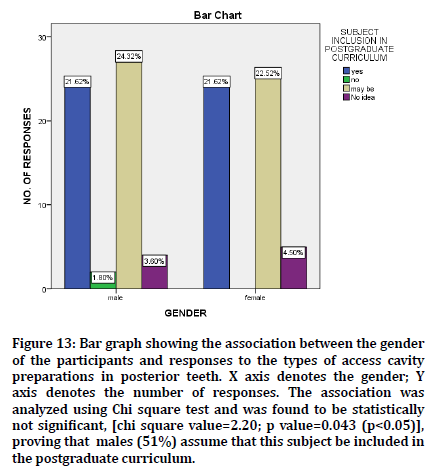
Figure 13. Bar graph showing the association between the gender of the participants and responses to the types of access cavity preparations in posterior teeth. X axis denotes the gender; Y axis denotes the number of responses. The association was analyzed using Chi square test and was found to be statistically not significant, [chi square value=2.20; p value=0.043 (p<0.05)], proving that males (51%) assume that this subject be included in the postgraduate curriculum.
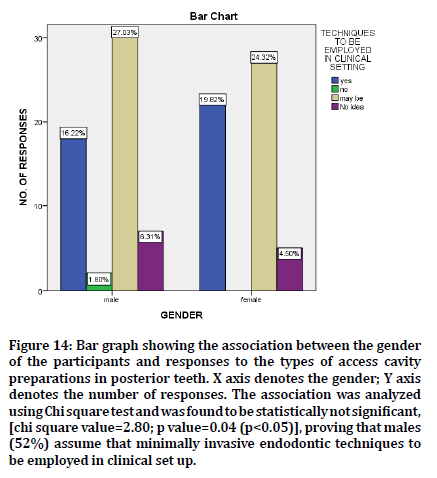
Figure 14. Bar graph showing the association between the gender of the participants and responses to the types of access cavity preparations in posterior teeth. X axis denotes the gender; Y axis denotes the number of responses. The association was analyzed using Chi square test and was found to be statistically not significant, [chi square value=2.80; p value=0.04 (p<0.05)], proving that males (52%) assume that minimally invasive endodontic techniques to be employed in clinical set up.
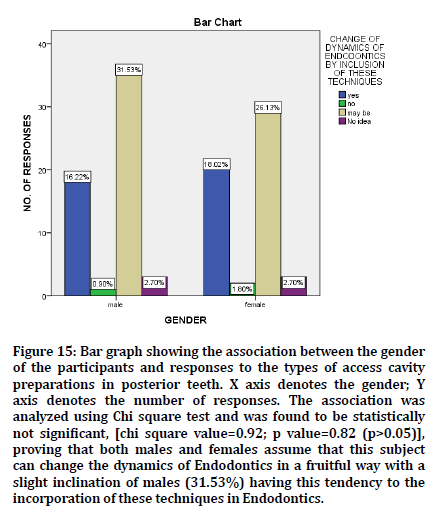
Figure 15. Bar graph showing the association between the gender of the participants and responses to the types of access cavity preparations in posterior teeth. X axis denotes the gender; Y axis denotes the number of responses. The association was analyzed using Chi square test and was found to be statistically not significant, [chi square value=0.92; p value=0.82 (p>0.05)], proving that both males and females assume that this subject can change the dynamics of Endodontics in a fruitful way with a slight inclination of males (31.53%) having this tendency to the incorporation of these techniques in Endodontics.
And also most of the practitioners feel that this topic should be incorporated in the post graduate curriculum. Also a lot of awareness should be created about minimally invasive endodontic procedures and the technique of doing them. Various hands on courses should be conducted to teach about these techniques to the already practicing endodontists. In this way, a detailed and thorough knowledge should be provided about these latest minimally invasive endodontic procedures and should be incorporated in the clinical set up in the best interest of the patient. But one should also keep in mind about the potential shortcomings of these procedures and extensive research should be done to provide evidence to suggest these procedures as alternative to conventional endodontic procedures before exclusively incorporating and embracing these procedures into clinical set up. 58.7% of participants feel that these modified minimally invasive endodontic procedures can change the future of endodontics.
It is almost intractable to eliminate the microbes in the root canal and impossible to render root canal systems of teeth bacteria-free. This was inferred after extensive research. The main objective of root canal treatment is to eliminate microorganisms from the root canal system and thereby prevent reinfection after the treatment [9] Herbert et al. proposed the objectives of cleaning and shaping. This included mechanical and biological objectives to clean and shape the root canal [16]. These objectives helped to promote the success of root canal therapy. In the pursuit of eradicating microorganisms from the canal the clinician should make sure that there is no extensive damage to the tooth structure which might lead to the loss of tooth structure in the process [26] Before starting the endodontic procedure, a proper diagnosis and treatment plan should be devised which involves minimal invasive approach. During access opening one should see if the following characteristics are present: minimal removal of tooth structure, biomechanical preparation of the root canal to preserve as much dentin as possible, retention of tooth structure. These approaches are known as Minimally Invasive Endodontics which can change the future of dentistry [27]. These less invasive procedures are also called ‘Endolight’ [28].
This minimally invasive endodontic treatment approaches which is called ‘Endolight’ has the following advantages:
1. Preservation and retaining structural integrity of the tooth [2].
2. Simplifies the treatment procedures which thereby avoids treatment complications [29].
3. These procedures may cause little pain.
4. Reduces the cost and inconvenience for patients [29].
Modern access cavity designs include the following [1,2,7,28,29].
a) Conservative Endodontic Access Cavity
b) Ninja Endodontic Access Cavity
c) Orifice-Directed Dentin Conservation Access Cavity
d) Truss access cavity preparation
e) X access cavity preparation
f) Calla Lily Enamel Preparation
Conservative endodontic access cavity
John Khademi and David Clark modified the conventional access cavity preparation and developed a conservative endodontic access cavity preparation to reduce the removal of tooth structure at the same time maintaining the structural integrity of the tooth for its longterm survival and function of endodontically treated teeth [2]. In this method, the teeth are accessed at central fossa and extended in a direction necessary to detect canal orifices, thus preserving the pericervical dentin, a part of the pulpal floor and remaining tooth structure [29]. Conservative endodontic cavity preparation was introduced to minimize the risk of fracture of endodontically treated teeth. However in a study done by Taha et al, Conservative and traditional endodontic cavity preparation showed almost similar fracture strength, which was comparatively lower than the intact teeth [30]. In another study done by Renato et al in maxillary premolars, he concluded that regardless of the type of access cavity preparation, CEC which preserves the marginal ridge did not exhibit resistance to fracture or failure modes or stress distribution [31].
Ninja endodontic access cavity
Ninja access cavity preparation is also called point access cavity preparation [32]. In this type of preparation, the oblique projection is towards the central fossa of the root orifices in an occlusal plane [31]. It is in parallel direction with the enamel at an angle of 90° or more to the occlusal plane. This makes it easier to trace the root canal orifices from any varied angulation [33]. Here comes the importance of soffit/banking which is nothing but the tiny lip or cornice of pulp chamber roof which can vary from 0.5mm to 3 mm. This stepped access cavity preparation is important in preserving the pericervical dentin [33]. However, there are certain complications such as fracture of files and canal transportation in teeth with these preparations due to difficulty in locating canals such as MB2 and difficulty in achieving straight line access [32].
Orifice-directed dentin conservation access cavity/‘truss’ access cavity
Rationale of this design is to preserve the dentin. A truss of dentin is left behind between the two access cavities that have been prepared. In this way, separate access cavity preparations are made to approach the canals [6]. For example, in mandibular molars, two separate access cavity preparations are made to approach the mesial and the distal canals whereas in maxillary molars, the mesiobuccal and the distobuccal cavities are together approached in one cavity and a separate access cavity preparation is made for the palatal canal is made [26].
Calla lily enamel preparation
When traditional parallel-sided access cavity preparation is compared with the Cala Lilly enamel preparation, unfavourable C factor and poor enamel rod engagement while cutting are typically present [4]. These features are also noticed when removing old amalgam or composite restorations. The enamel is prepared at 45 with the Calla Lily shape. This modified preparation will allow involvement of nearly the entire occlusal surface [16].
These above-mentioned modified preparations enhance the fracture resistance of the tooth by preserving the maximum amount of dentin [34] However, the instrumentation efficacy is questionable when compared to traditional access cavity preparations [34]. The lack of clinical judgement may lead to inaccuracy while cleaning and shaping. This may also lead to iatrogenic errors [5]. There is lack of appropriate clinical evidence to prove that conservative access cavity preparations are an alternative to traditional access cavity preparations. In case of maxillary molars, it was found in a study that negotiation of MB2 canal was lower in conservative access cavity preparations compared to traditional access cavity preparations [36]. Nonetheless, the conservative access cavity preparations allow for the preservation of maximum sound dentin thus increasing the fracture resistance of the tooth [35].
According to the study done by [4], it was concluded that conservative endodontic access cavities such as CEC and NEC had an impact in the increased fracture strength of teeth compared with those with TEC. Moreover, restored CEC and NEC did not play a role in reducing the fracture strength, but they did influence the fracture pattern of intact teeth. On the contrary to the studies done previously, in this survey 43% of the dentists find better enabling of cleaning and shaping of the canals after access cavity preparation [16].
According to a study done [5,16] Truss access cavity preparation did not increase the fracture strength of endodontically treated teeth in comparison with CECs and TECs. Moreover, the loss of mesial and distal ridges reduced the fracture strength of teeth significantly.
Also the amount of stress distribution within the teeth may differ in traditional endodontic access cavity preparation and conservative access cavity preparation. According to a study done by Chad Allen, he demonstrated via finite element analysis that the stress distribution within the remaining tooth structure was higher in traditional access cavity preparation compared to conservative access cavity preparations [36].
The main limitation of this study is that it relies on the questionnaire based survey rather than direct evaluation and comparison of the data. The results are based on the knowledge and opinion of the practitioners and also the study is restricted to only the types of different access cavity preparations but not their methods [37,38].
Conclusion
The above minimally invasive procedures are all devised in the best interest of the patient and also the minimally invasive endodontic procedures demand the use of microscopes, ultrasonics, ultramodern file systems which can aid in thorough cleaning and shaping of the canals and also requires the clinician to have in depth knowledge and expertise to perform these procedures.
But one should also keep in mind about the limitations and shortcomings of these procedures which outweigh the benefits associated with these procedures. These procedures are commonly prone to iatrogenic errors which may compromise the outcome. However extensive research should be carried out to prove these procedures as an alternative to traditional procedures.
Acknowledgement
Nil
Conflicts of Interest
Nil
References
- Anjum SA, Hegde S, Mathew S, et al. Minimally invasive endodontics-A review. J Dental Orofacial Res 2019; 15:77-88.
- Gluskin AH, Peters CI, Peters OA, et al. Minimally invasive endodontics: Challenging prevailing paradigms. Brit Dental J 2014; 216:347.
- Mookhtiar H, Hegde V, Srilatha S,et al. Conservative endodontics: A truss access case series. Int J Appl Dent Sci. 2019; 5:213-18.
- Plotino G, Grande NM, Isufi A, et al. Fracture strength of endodontically treated teeth with different access cavity designs. J Endodontics 2017; 43:995-1000.
- Mahalaxmi S. Minimally invasive endodontics and endo-endorestorative–prosthodontic continuum: The right balance? J Operative Dent Endodont 2019; 4:42-53.
- Abou-Elnaga MY, Alkhawas MB, Kim HC, et al. Effect of truss access and artificial truss restoration on the fracture resistance of endodontically treated mandibular first molars. J Endodontics 2019; 45:813-817.
- Mukherjee P, Patel A, Chandak M, et al. Minimally invasive endodontics a promising future concept: A review article. Int J Scient Study 2017; 5:245–251.
- Jiang HW. Theory and practice of minimally invasive endodontics. Chinese J Stomatol 2016; 51:460-464.
- Kanchan Hegde. Unusual ways usual destination. Intern J Cur Med Pharma Res 2018; 4:2969-2971.
- Mathew ST, Rajah JS. Minimally invasive endodontics. J Dent Oral Hygiene 2014; 6:36-38.
- Azeem RA, Sureshbabu NM. Clinical performance of direct versus indirect composite restorations in posterior teeth: A systematic review. J Conservative Dent 2018; 21:2–9.
- Govindaraju L, Neelakantan P, Gutmann JL. Effect of root canal irrigating solutions on the compressive strength of tricalcium silicate cements. Clin Oral Investigations 2017; 21:567–571.
- Janani K, Sandhya R. A survey on skills for cone beam computed tomography interpretation among endodontists for endodontic treatment procedure. Indian J Dental Res 2019; 30:834–838.
- Jenarthanan S, Subbarao. Comparative evaluation of the efficacy of diclofenac sodium administered using different delivery routes in the management of endodontic pain: A randomized controlled clinical trial. J Conser Dentistry 2018; 21:297–301.
- Khandelwal A, Palanivelu A. Correlation between dental caries and salivary albumin in adult population in Chennai: An In Vivo study. Braz Dental Sci 2019; 22:228–233.
- Malli Sureshbabu N, Selvarasu K, V JK, et al. Concentrated growth factors as an ingenious biomaterial in regeneration of bony defects after periapical surgery: A report of two cases. Case Reports Dent 2019; 7046203.
- Manohar MP, Sharma S. A survey of the knowledge, attitude, and awareness about the principal choice of intracanal medicaments among the general dental practitioners and nonendodontic specialists. Indian J Dental Res 2018; 29:716–720.
- Corsentino G, Pedullà E, Castelli L, et al. Influence of access cavity preparation and remaining tooth substance on fracture strength of endodontically treated teeth. J Endodontics 2018; 44:1416-1421.
- Nandakumar M, Nasim I. Comparative evaluation of grape seed and cranberry extracts in preventing enamel erosion: An optical emission spectrometric analysis. J Conser Dentistry 2018; 21: 516–520.
- Poorni S, Srinivasan MR, Nivedhitha MS. Probiotic strains in caries prevention: A systematic review. J Conservative Dent 2019; 22:123–128.
- Rajakeerthi R, Ms N. Natural product as the storage medium for an avulsed tooth–A systematic review. Cumhuriyet Dental J 2019; 22: 249–256.
- Rajendran R, Kunjusankaran RN, Sandhya R, et al. Comparative evaluation of remineralizing potential of a paste containing bioactive glass and a topical cream containing casein phosphopeptide-amorphous calcium phosphate: An in vitro study. Pesquisa Br Odont Clin Integrada 2019; 19:1–10.
- Ramarao S, Sathyanarayanan U. CRA grid-A preliminary development and calibration of a paper-based objectivization of caries risk assessment in undergraduate dental education. J Con Dentistry 2019; 22:185–190.
- Siddique R, Nivedhitha MS. Effectiveness of rotary and reciprocating systems on microbial reduction: A systematic review. J Conservative Dentistry 2019; 22:114–122.
- Siddique R, Sureshbabu NM, Somasundaram J, et al. Qualitative and quantitative analysis of precipitate formation following interaction of chlorhexidine with sodium hypochlorite, neem, and tulsi. J Con Dentistry 2019; 22:40–47.
- Siddique R, Nivedhitha MS, Jacob B, et al. Quantitative analysis for detection of toxic elements in various irrigants, their combination (precipitate), and para-chloroaniline: An inductively coupled plasma mass spectrometry study. J Conserv Dentistry 2019; 22: 344–350.
- Teja KV, Ramesh S, Priya V, et al. Regulation of matrix metalloproteinase-3 gene expression in inflammation: A molecular study. J Conservative Dent 2018; 21:592–596.
- Auswin MK, Ramesh S. Truss access new conservative approach on access opening of a lower molar: A case report. J Advan Pharm Edu Res 2017; 7.
- Yuan K, Niu C, Xie Q, et al. Comparative evaluation of the impact of minimally invasive preparation vs. conventional straight-line preparation on tooth biomechanics: a finite element analysis. Eur J of Oral Sci 2016; 124:591–596.
- Wolters WJ, Duncan HF, Tomson PL, et al. Minimally invasive endodontics: A new diagnostic system for assessing pulpitis and subsequent treatment needs. Int Endod J 2017; 50:825-829.
- Bürklein S, Schäfer E. Minimally invasive endodontics. Quintessence Int 2015; 46:119-124.
- Ahmed HMA. Thoughts on conventional and modern access cavity preparation techniques. Lond Engl 2015; 9:287–288.
- Roperto R, Sousa YT, Dias TR, et al. Biomechanical behavior of maxillary premolars with conservative and traditional endodontic cavities. Quintessence Inter 2019; 50:350-356.
- Saygili G, Uysal B, Omar B, et al. Evaluation of relationship between endodontic access cavity types and secondary mesiobuccal canal detection. BMC oral health. 2018; 18:121.
- Connert T, Zehnder MS, Amato M, et al. Microguided Endodontics: A method to achieve minimally invasive access cavity preparation and root canal location in mandibular incisors using a novel computer-guided technique. Intern endodontic J 2018; 51:247–255.
- Özyürek T, Ülker Ö, Demiryürek EÖ, et al. The effects of endodontic access cavity preparation design on the fracture strength of endodontically treated teeth: Traditional versus conservative preparation. J Endodontics 2018; 44:800-805.
- Pawar AM, Pawar MG, Kokate SR. Meant to make a difference, the clinical experience of minimally invasive endodontics with the self-adjusting file system in India. Indian J Dental Res 2014; 25:509–512.
- Jalali P, Allen C, Meyer C, et al. (2018) Stress distribution in a tooth treated through minimally invasive access compared to one treated through traditional access: A finite element analysis study. J Conserv Dent 2018; 21:505.
Author Info
Mulumoodi Rama Sowmya* and Manish Ranjan
Department of Conservative Dentistry and Endodontics, Saveetha Dental College and Hospitals, Saveetha Institute of Medical And Technical Sciences, Saveetha University Tamilnadu, Chennai, IndiaCitation: Mulumoodi Rama Sowmya, Manish Ranjan, Knowledge, Attitude and Practice Survey on Various Types of Access Cavity Preparations in Posterior Teeth among Endodontists and Post Graduate Students residing in south India, J Res Med Dent Sci, 2021, 9 (2): 300-308.
Received: 23-Sep-2020 Accepted: 18-Feb-2021
